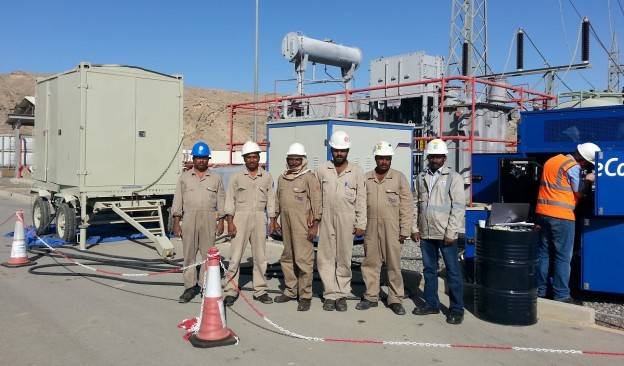A dry air system is essential equipment, particularly in the electric power industry, to ensure transformers remain operational, safe, and moisture-free. GlobeCore’s Mojave Heat is an advanced dry air system specifically engineered to protect transformers from moisture and contamination during maintenance and repair operations.
Importance of Dry Air Systems in Transformer Maintenance
Power transformers are costly, complex, and critical pieces of equipment, vulnerable to moisture ingress during maintenance or repairs. Transformer insulation, typically hygroscopic, absorbs moisture readily, compromising its effectiveness and reducing its lifespan. Consequently, utilizing a reliable dry air system during transformer depressurization and maintenance is crucial to avoid significant operational risks and financial losses.
Risks of Transformer Depressurization Without a Dry Air System
Operating without a dedicated dry air system presents significant risks, such as:
- Increased moisture ingress into transformer insulation
- Reduced insulation lifespan and reliability
- Potential failure of critical transformer components
Specific operating conditions required without a dry air system include:
- Environmental humidity must be below 85%
- Partial depressurization limited to under 20 hours
- Full depressurization limited to under 16 hours
- Transformer active part temperature must remain below 10°C
However, these conditions are challenging to maintain consistently, highlighting the necessity of employing systems like Mojave Heat.
Transformer Insulation Heating Methods
Prior to transformer depressurization, insulation heating is essential. Common heating methods include:
- Induction coils: Labor-intensive and primarily used for drying.
- Electric furnace heaters: Low efficiency and high fire risks.
- Oil circulation heating: Efficient but involves complex oil handling.
- Direct Current (DC) heating: Efficient heating through transformer windings; however, accuracy in calculation and execution is vital.
Despite these methods, pairing insulation heating with a dry air system significantly enhances transformer protection.
GlobeCore Mojave Heat Dry Air System Overview
GlobeCore’s Mojave Heat dry air system effectively addresses moisture challenges during transformer maintenance by drying and purifying the air before it enters transformer tanks. Its advanced sorbent technology ensures moisture-free conditions, safeguarding transformers throughout repair and servicing stages.
Key Components and Functionality
The Mojave Heat system consists of:
- One or two sorbent columns filled with synthetic zeolite
- High-performance blower
- Dust filter
- Air distributor and control valves
- Advanced automated control cabinet
This design allows efficient drying and cleaning of incoming air, with sorbent regeneration capabilities internally managed by the unit.
Mojave Heat Operating Principle
The Mojave Heat dry air system operates by passing air through autonomous adsorbent columns containing zeolite, effectively removing moisture and mechanical particles. The unit maintains drying temperatures below 400°C to protect sorbent integrity.
Advantages of Using Mojave Heat Dry Air System
Employing Mojave Heat during transformer depressurization offers significant benefits:
- Enhanced Moisture Protection: Ensures transformer insulation remains dry and efficient.
- Controlled Depressurization: Enables staged depressurization with complete transformer assembly, reducing operational complexity.
- Reduced Heating Requirements: Minimizes or eliminates the necessity for additional transformer heating processes.
Mojave Heat Automation and Control Features
GlobeCore’s Mojave Heat features a robust semi-automatic control system, which operators can adjust manually if needed. Automation significantly reduces human error, improving safety and operational efficiency. Key automated components include:
- PID controllers for precise temperature regulation
- Frequency converters controlling air supply to transformers
- Industrial controllers and remote input/output modules
- Dew point sensors ensuring optimal drying conditions
Flexible Design Options for Mojave Heat
Mojave Heat is available in versatile configurations, suitable for various operational contexts:
- Containerized Design: Meets European Union standards for outdoor operation, providing comprehensive weather protection.
- Trailer-Mounted Design: Fully roadworthy unit featuring brake systems, safety lights, spare wheel, toolbox, and spare parts for mobile operations.
Steps of Transformer Repair Supported by Mojave Heat
Mojave Heat supports comprehensive transformer repair stages, including:
- Initial preparation
- Busbar disconnection
- Transformer disassembly
- Heating procedures
- Cooling system repairs
- Active part inspection and maintenance
- Reassembly and oil filling
- Final testing and operational verification
Throughout these stages, Mojave Heat ensures moisture-free air, preserving transformer integrity and functionality.
The GlobeCore Mojave Heat dry air system offers critical moisture protection, precise air drying capabilities, and user-friendly automation, essential for efficient and safe transformer maintenance. Implementing Mojave Heat during transformer repair significantly extends transformer service life, improves operational reliability, and reduces maintenance-related costs and risks.




